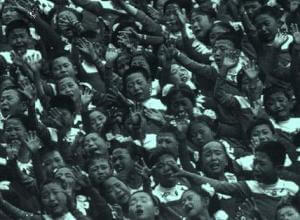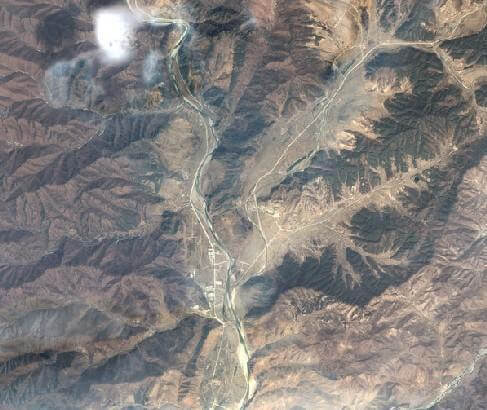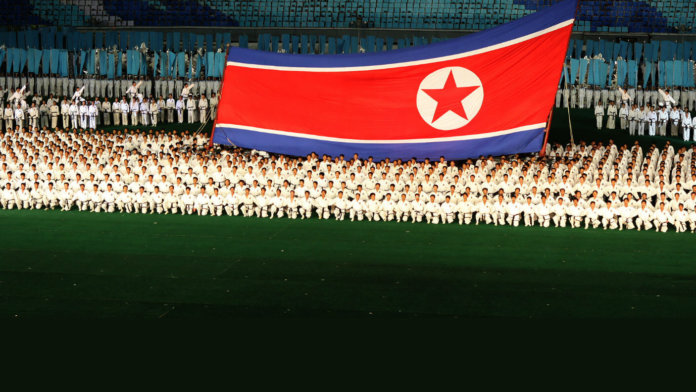 No one really knows how bad it is, but it’s much worse than I thought possible. Piecing together information from satellite images and eye witness accounts, Amnesty International suspects that the horrific concentration camps in North Korea are growing. Some 200,000 people live as slaves – enduring starvation, torture, and rape while performing hard labor. Many die every year, only to be replaced by fresh bodies. Of those that survive, few will ever be released. Deemed ‘prisoners’, the victims of North Korea’s political pogroms are interned for the smallest criticisms of the regime of Kim Jong-Il, and when they are carried away their extended families are rounded up as well. This is not genocide, it’s not a war crime, it’s an unending consequence of North Korea’s authoritarian government. And it’s been getting worse for the last decade. Amnesty International’s satellite research shows these slave camp expanding, their populations swelling with ‘criminals’ as the general population starves inside its borders and refugees who are caught trying to leave North Korea are executed…or sent to these gulags. Sixty years ago the world was embroiled in a global war that saw some of the worst crimes against humanity we had ever experienced. Today, the concentration camp lives on in North Korea. Will this evil still be with us another sixty years from now? Despite all my hope about the future, a voice inside me says ‘yes’…I can’t believe this is still happening.
No one really knows how bad it is, but it’s much worse than I thought possible. Piecing together information from satellite images and eye witness accounts, Amnesty International suspects that the horrific concentration camps in North Korea are growing. Some 200,000 people live as slaves – enduring starvation, torture, and rape while performing hard labor. Many die every year, only to be replaced by fresh bodies. Of those that survive, few will ever be released. Deemed ‘prisoners’, the victims of North Korea’s political pogroms are interned for the smallest criticisms of the regime of Kim Jong-Il, and when they are carried away their extended families are rounded up as well. This is not genocide, it’s not a war crime, it’s an unending consequence of North Korea’s authoritarian government. And it’s been getting worse for the last decade. Amnesty International’s satellite research shows these slave camp expanding, their populations swelling with ‘criminals’ as the general population starves inside its borders and refugees who are caught trying to leave North Korea are executed…or sent to these gulags. Sixty years ago the world was embroiled in a global war that saw some of the worst crimes against humanity we had ever experienced. Today, the concentration camp lives on in North Korea. Will this evil still be with us another sixty years from now? Despite all my hope about the future, a voice inside me says ‘yes’…I can’t believe this is still happening.
We are confronted with so many atrocities in global news that it’s hard to pierce our desensitized skin. I can’t describe the horrific conditions in the North Korean slave camps, but Jeong Kyoungil can. He was detained for years at Yodok, officially known as Kwan-li-so (reeducation center) Number 15. Inside its walls he fought frostbite from the bitter cold, starvation, endless work, and a continual stripping of his humanity. He describes how the death of fellow inmates was a joy – an opportunity – because burying these bodies earned an extra helping of food. To starving slaves such as Kyoungil, a few more bites of corn gruel was the difference between life and death. In the following video from Amnesty Internation, Kyoungil describes more of his time in Yodok, and the soul wrenching things he saw there.
Since the formation of these sinisterly named reeducation centers in the 1950s, Amnesty International counts only a sparse 30 or so individuals who have managed to be freed and then leave North Korea to tell their tales. Among them was Kang Chol-Hwan who survived a decade in Yodok, fled to China, and eventually wrote an account of his time in the camp: Aquarium of Pyongyang. Yet those who are consigned to reeducating “Revolutionary Zones” in these camps aren’t the worst off, for there is the possibility that they will be freed after years of deadly conditions. In the camps’ “Total Control Zones” no end is in sight. Dissidents and their families who are sent to the Total Control Zones will be there for the rest of their lives. Short or long as they may be. In the long history of the North Korean gulags, Amnesty International counts only three individuals to have escaped, fled far enough, and survived long enough to tell their tales. North Korea controls the information within its borders, and they leave precious few to bare witness to the crimes that go one inside the Kwan-li-so.

While it’s hard to imagine those crimes getting worse, it’s very likely they are becoming more numerous. Amnesty International recently published satellite imagery that shows North Korea’s prison camps have expanded considerably in the last decade. Amnesty International has been working for years to highlight the growing human rights abuses in North Korea. Their latest work took satellite images of four of the six major camps associated with political prisoners. These camps, located in South Pyongan, South Hamkyung, and North Hamkyung show major expansions in facilities for both prisoners and guard personnel when compared to images from 2001. Along with these overhead photos, Amnesty International was able to talk with some prisoners, such as Jeong Kyoungil. In Yodok alone, there is thought to be roughly 50,000 victims held without legal recourse. It is very likely that most of these people will die in Yodok due to starvation. Between 1999 and 2001, it is estimated that nearly 40% of the camp population died of malnutrition. Others lost ears, toes, and limbs to frostbite. Others were raped and forced to abort children. The fate of most is simply unknown.
North Korea’s government may hide these crimes from their population, and they may deny these atrocities to the UN, yet these camps are blatantly visible from above. North Korea seems to have done little to disguise their size and growth from satellites passing overhead. You can even see some of these structures in the old photos on Google Earth and other digital globes (go to 39.674163 N, 126.851406 E). Perhaps North Korea’s cavalier attitude about these camps is due to the general lack of attention they receive in world press. Amnesty International’s recent revelation about North Korean camps has garnered some attention in the New York Times and on NPR, but little in other mainstream news outlets. I don’t know which is more shocking, the fact that these camps exist in plain site, or the fact that after they are uncovered the world seems to shrug, and the major media hardly even seems to be covering it. In 2004, Japan’s FujiTV ran a video clip that was reportedly recorded at Yodok…but it eventual passed out of public perception as its veracity was impossible to determine.
One place where concerns over North Korean prison camps seem to be growing is on the internet. There are many organizations aimed at raising awareness on conditions both in these prisons and in the nation in general, some religious others secular: LiNK, Helping Hands Korea, and The Committee for Human Rights in North Korea to name a few. There have been several documentary films about conditions in North Korea. Shadows and Whispers, now more than a decade old, explores the life of refugees. With regular cycles of famine, North Korea see millions go malnourished or face outright starvation every year. Many of those who flee these dire conditions go into Northern China. A good portion of those who are smuggled across the border are children, sent away by parents hoping that such an exodus will keep them alive. There, their lives seem little better as they face extremely high rates of human trafficking and police brutality. As China doesn’t officially categorize fleeing North Koreans as refugees, they are free to extradite them back across the border where many will face possible execution. The producers of Shadows and Whispers have made a portion of the film available for free online. Here is the trailer of the documentary:
In part, North Korea can starve its citizens, imprison them, and execute those who flee because they maintain such a tight control on public information. All news outlets are state controlled, and visitors are allowed little access to potentially ’embarrassing’ areas. Violators are dealt with harshly, both in Korea and China. Adrian Hong, founder of LiNK, was arrested in China for helping North Korean refugees. Even casual harassment helps silence would be detractors: one knowledgeable contact I spoke to was unable to go on the record because he/she has plans on returning to North Korea, and believed that being linked to an article critical of the regime would cause the nation to deny his/her visa. Apparently, googling your name is part of the application process. Use (and possession) of video cameras is tightly controlled, and foreign press agents are given little access.
Yet even the most authoritarian governments cannot control information completely. Camp survivors, documentary filmmakers, and human rights activists are using email, the internet, and even text message newsletters to spread word about the situation in North Korea. It reminds me, somewhat, of the years leading up to the fall of the Soviet Union – government institutions getting ‘leaky’ with information was a precursor to the change in regimes. The rise of technology which could easily disseminate news without central government approval was one of the factors that allowed Ray Kurzweil to accurately predict the collapse of the Soviet system. This continues today. In recent years we’ve seen how communications technologies and freedom of information helped foment change in the Middle East. In some parts of the world the tech developments we discuss on Singularity Hub may be making it harder to perpetrate crimes against humanity. Perhaps current technologies – the internet, mobile devices, etc will provide similar leverage to end the atrocities in North Korea. And perhaps emerging food technologies, like those making their way to China, could help with the food shortages that plague the nation.
Of course, those are mainly my own hopeful dreams, and I fear the truth that these concentration camps in North Korea teach us is far from hopeful. The nation is undergoing an Orwellian nightmare. Starvation, slave camps, endless propaganda – these are the trappings of 1984 alive and well in 2011, and they may be fueled by modern technology rather than hindered by them. I consider myself inured to most of the world’s ills due to prolonged exposure to blaring 24 hour news streams that fry sensibilities with their constant emotional appeals. Yet there is something in the news of 200,000 North Korean slaves that pushes past my modern American apathy and sets my teeth on edge. The world has seen the forest fires of genocide sweep through populations and leave scars in humanity that we may never heal from. Yet North Korea’s crimes aren’t blazing…they are a smoldering sin that shows no sign of burning itself out. Hundreds of thousands have been ‘processed’ through these camps, dying on site or leaving with broken minds and bodies. Hundreds of thousands more will come through as these camps continue to grow. And the death toll will slowly rise, and the people of North Korea will remain starved, cowed, and broken because no one from outside is coming to rescue them (with due respect to the NGOs and nonprofits aimed at doing exactly that…they just don’t have the power to put an end to these slave camps).
China is complicit in these atrocities, or at the very least enabling them with their immigration policies…and that is appalling on an entirely new level. I can admire China’s growth in infrastructure and technology, it’s pursuit to compete on a global scale, but what good is all that growth if it allows these crimes to go on next door? Even opening their borders would be something…
Other nations around the world have similar problems. There are crimes against humanity on every continent, in every region. They may not always be visible to satellites, but they are there. The US, EU, Brazil, China, India…if these nations used their (emergent) technological good fortune to champion the rights of these victims perhaps things could change. I fear that unless economically powerful countries take up the charge to end human rights abuses, the world will always be plagued by concentration camps.
For now the reality of the situation is that little is bound to change in North Korea unless more people become both aware and outraged by the human rights violations that continue to occur. I know that gulags, even those revealed by kickass satellite technology, are a little out of Singularity Hub’s purview. I hope, however, that you’ll see this story as a great chance to experiment with some human rights crowd sourcing. Go to Amnesty International’s website (or any such organization of your choosing) and see if you can’t help spread the word and raise awareness. 200,000 political prisoners, hundreds of thousands of refugees, and millions of hungry citizens may all benefit from your time.
In sixty years we could live in a world where abundant energy resources, ample food supplies, and automation mean that even the poorest people have their basic needs met. Or, if we allow it, we could live in a world that makes great strides forward, but that can never rid itself of the abhorrent authoritarian tool that is the concentration camp.
[images: Amnesty International, Aquariums of Pyongyang]
[sources: Amnesty International]
Banner Image Credit: Roman Harak



